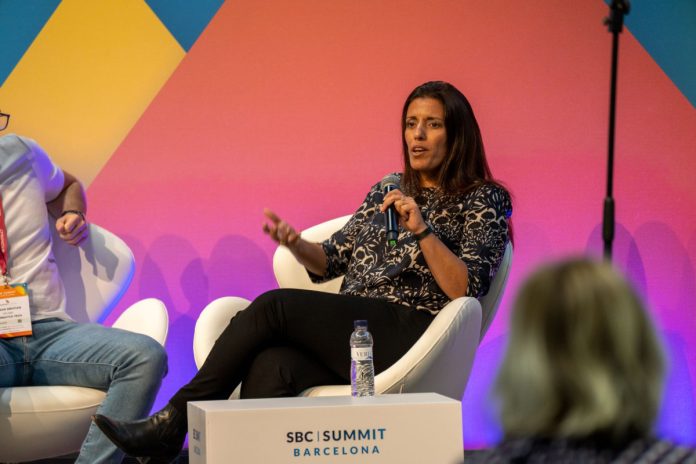Shelly Suter-Hadad, transformational leader and industry veteran, takes a pause after 10 years in executive roles to reflect on the biggest challenges that companies face today and what she sees on the horizon for future-facing leadership.
What prompted you to take a pause between positions?
After spending more than 13 years on the B2C side of gaming and sports betting, I wanted to consciously take the opportunity to pause and reflect. We often leap from one high-speed position to the next, without a time for transition. Yet, it’s in the transition that we are able to reflect and build upon learnings. So I am doing just that and using this time of transition to share my reflections, learnings and methods with other leaders and operators as well.
What are the most urgent topics in the industry today?
On top of the well-known topics of compliance and the increasing regulation standards that have been occupying industry leaders and professionals the past years, the industry has become more and more saturated. Margins are tougher than ever and all eyes are on marketing spend and overhead.
While this has been the norm in other industries for decades, the gaming industry’s regulatory and competitive landscapes were only built within the past 10 years, leaving operators to respond. Optimising marketing spend and adopting a stronger ROI culture have become key success factors — and for some, the way to survive.
Another urgent topic is the transition from start-up mode to scaling mode as businesses grow. It often requires adopting new ways of working, which suit a larger organisation with greater volumes of employees, revenues and customers—in other words, more complexity. For example, if you run a 25-person event versus a 500-person event, your planning and level of requirements will be very different. With 25 invitees, the RSVP list could be done manually, but a list of 500 guests would need to be supported by software.
It’s the same with businesses that grow. The way a business operates in its start-up phase is unlikely to scale efficiently and effectively as the company grows in volumes and complexity.
Finally, our rising millennial talent is another hot topic that I hear rumbling amongst my colleagues across industries. This generation comes with a different style and set of expectations on everything from a business’ purpose to its leadership and work environment. How do we motivate and lead the talent of the future?
I do not have all the answers for these, but these are areas that I am actively exploring.
What is behind the big focus on marketing spend and performance?
In most industries, the optimisation of marketing budgets and overhead is the holy grail. It delivers more value and profit without the need of pumping in additional investment or resources. In general, the gaming industry was a little late to realise and adapt to this, which is why we see companies struggling today. However, some companies did step up their game and optimised across the board, especially after the US closure in 2006 and the rapid growth of regulated markets in the past five to seven years.
In the past years, many factors have brought this topic higher on the agenda. Increased regulation and compliance requirements have impacted headcount as companies had to invest in new competencies. Restrictions have taken a toll on customer value across most territories. Meanwhile, we’ve seen splashy spends on marketing efforts that haven’t delivered impact or return. Add in the fierce competition and we have a perfect storm hitting margins and making profitability more challenging than ever before.
How can a company begin to optimise its marketing spend?
Start by getting your data in order. This is no easy feat, but a requirement for becoming a KPI-driven company that is able to set realistic goals and make smart projections. Leverage the data to perform rapid reviews and optimization of campaigns, ensuring every dollar spent will deliver value in the end. Multi-touch attribution models are very helpful in making the right decisions about the impact of marketing channels and the budgets for each.
Shift towards a retention-based acquisition mindset. In other words, when planning a big campaign or market entry, design the full experience of a new customer as part of the acquisition flow. The onboarding experience gives us a chance to ensure the customer will stick around for more than just one session.
Look at the consistency between messages and visuals throughout the entire acquisition and onboarding journey. Don’t stop there, build deeper into the journey by mapping the lifetime engagement strategy of a customer. The success metric isn’t the acquisition, it’s the value generated month after month.
Let’s dig deeper into this idea of retention-based acquisition. Tell us more.
Firstly, every brand or product is unique, so there’s no one-size-fits-all approach, but there are some general principles:
1) Have the entire journey and experience in mind from the start. We tend to separate the acquiring-the-customer part from the winning-hearts part. The latter happens when you onboard a customer and engage with him throughout his relationship with your business.
2) Use learnings from the data of your existing customer base to understand the demographics and behaviours of your most loyal customers; then target and acquire an audience that is most likely to stay loyal. With the right tracking in place, you can learn so much from your customers—this alone can change a whole marketing strategy.
3) Ensure the product experience is engaging and smooth; you don’t want to give a new customer any reason to go someplace else. For example, look at how social gaming keeps players engaged. You don’t need to see ads reminding you to play the game. Instead, you know there’s always something new waiting for you in the app and you want to go back and check. Aim for real-time integrations that track user behaviours and deliver engaging experiences while keeping players safe.
What role does the brand play?
The brand plays a huge role; it exists at the core of your product and your customer journey. It’s the glue that holds it all together and when we’re talking about a customer journey with seemingly infinite paths and touchpoints, brand clarity and consistency is key. After all, in an industry filled with sameness, it’s the brand that is often the unique differentiator between the standout challengers and all the other operators.
To transform marketing, do companies need to shift internal competencies?
Yes, this is where companies fall behind because they do not recognise the need for such a shift. As a company transitions from start-up to scale-up phase, or from big above-the-line campaigns to highly efficient, performance marketing, it requires a team that is experienced and specialised in that phase. Without the right competencies onboard, whether internal or external, the process will take considerably more time and investment and is less likely to succeed.
Sounds like a transition that many companies need to go through. Does it reach beyond marketing?
Yes, it could be across the entire organisation or just a part of it. Compliance, for example, was an area that was taking the focus of most gaming B2C and B2B operators these past five years and consuming more tech and operational resources.
As a result, “service delivery” and “product life cycle management” became areas that were strong candidates for scaling, to accommodate the increasing demands for product compliance and innovation. Both reflect the need for making the most return on resources and overhead.
How can leaders best navigate their organisations through change?
Leading a change is not a one-wo/man show, there need to be change agents or ambassadors across all business areas. A key phase is competency evaluation; in most cases, the people that built the business may not be the best fit for navigating the next step into the scaling stage.
It’s important to keep a good balance between the big picture and the specifics. When navigating such a transition, you are required to be both the pilot and oversee the course, as well as to roll up your sleeves and get things done when turbulence hits. The key is to balance between the two and not get consumed by the turbulence.
Don’t be afraid to make bold decisions, even if it means you won’t be the most popular leader in the short-term; in the end, when the success comes, you will get your glory.
And maybe above all, it all starts with the “why”, the purpose of change. Communication is key. Use storytelling and make the change relatable. The more transparent you can be, the more the organisation will understand the transition and step up to help.
What else do you see on the horizon?
The post-pandemic paradigm shift is driving the evolution of what will be the future organisation. From the purpose of office spaces to the outlook on employment, the tides of change are clear. Millennials are climbing the ranks of leadership and Gen Z are entering the workforce with new sets of expectations on their employers. This is a great time for future-facing leaders to pause, reflect and recalibrate.














